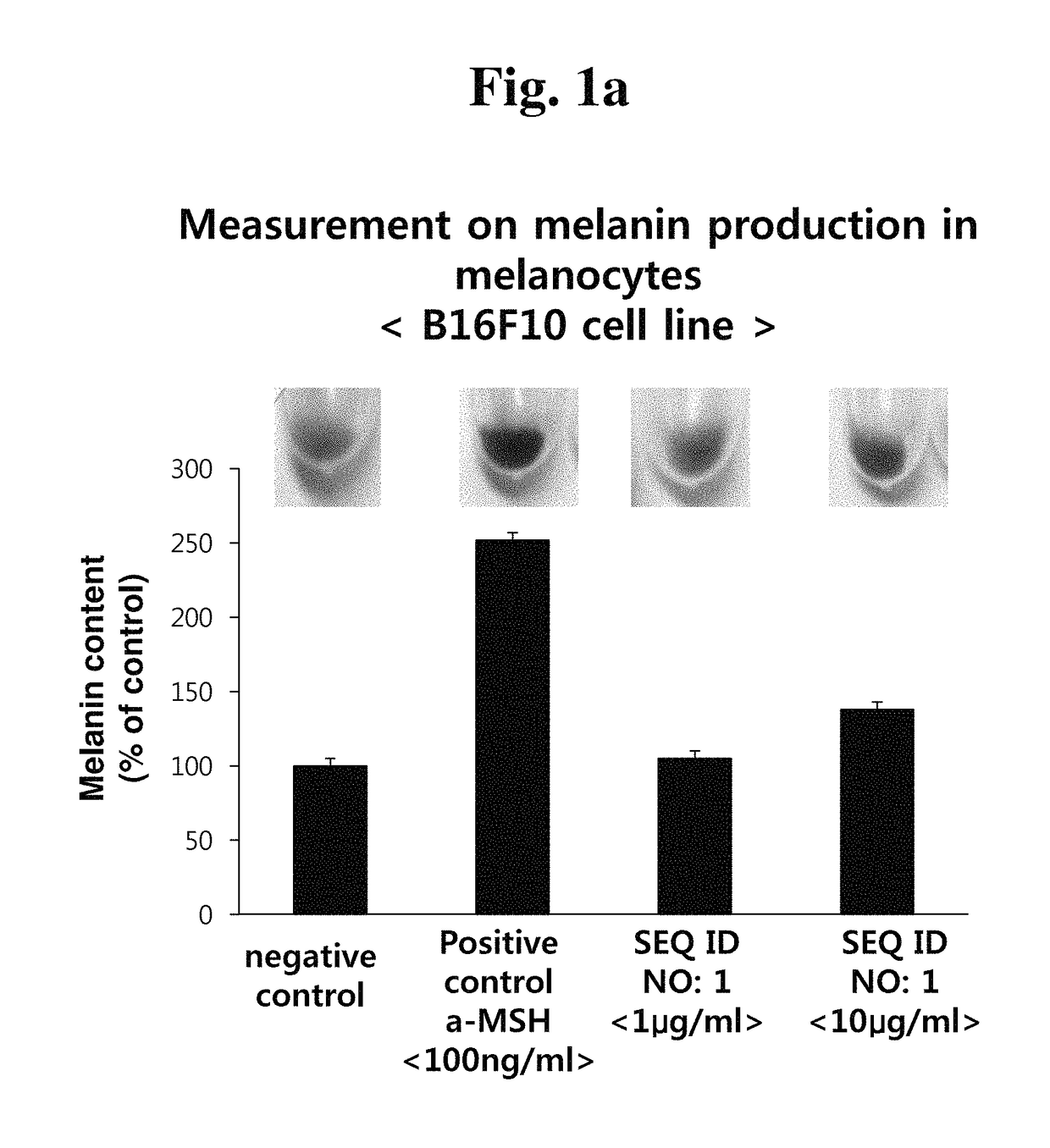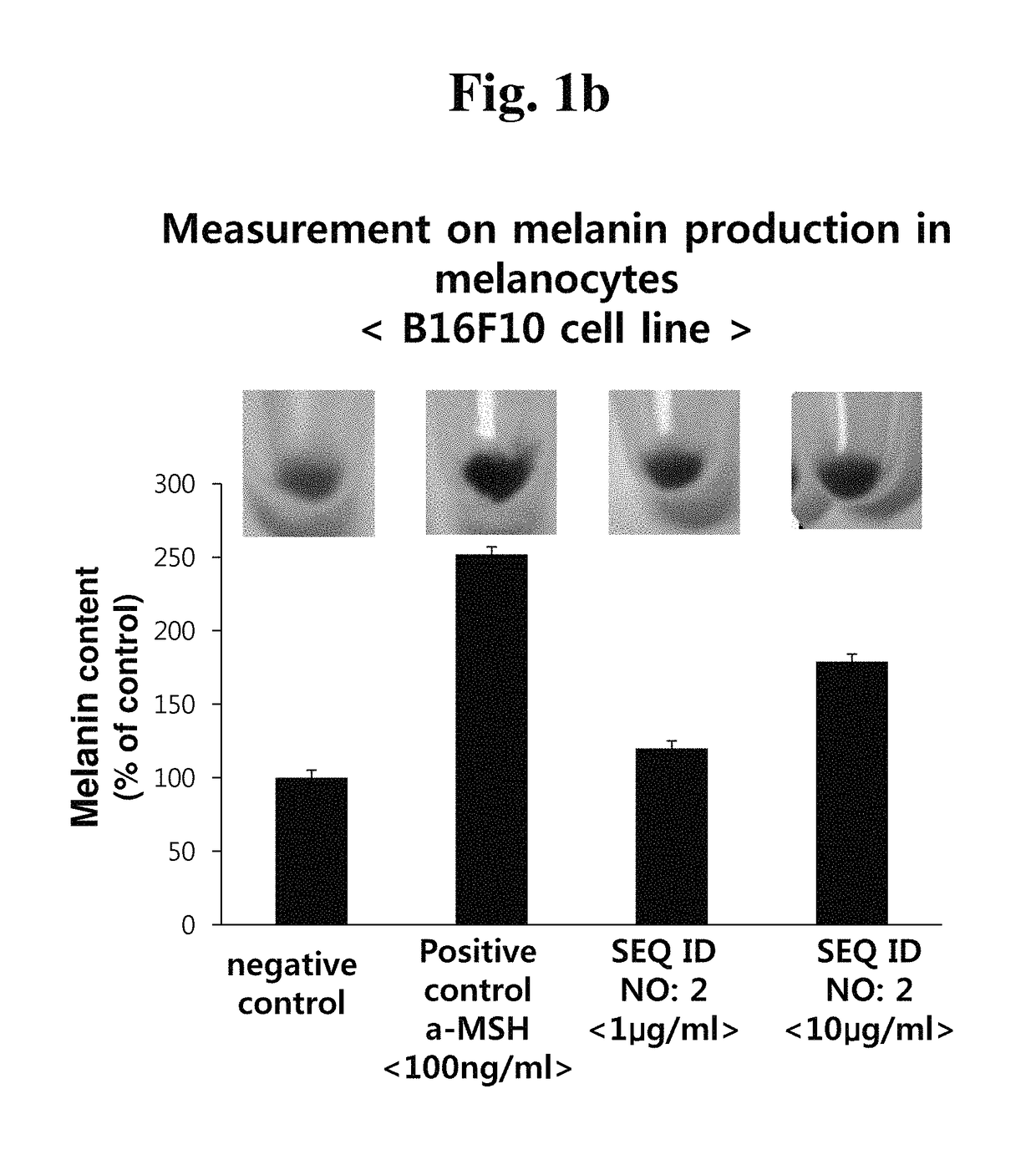Peptide having efficacy for remedying hypopigmentation and inhibiting adipogenesis, and use of same
a technology of peptides and adipogenesis, which is applied in the direction of peptides/protein ingredients, pharmaceutical non-active ingredients, peptides, etc., can solve the problems of limited appetite suppressant medicines, huge social and economic losses, and abnormal skin pigmentation, so as to increase the expression of mitf, increase the expression of tyrosinase, and increase the phosphorylation of mi
- Summary
- Abstract
- Description
- Claims
- Application Information
AI Technical Summary
Benefits of technology
Problems solved by technology
Method used
Image
Examples
example 1
nt of Melanin Production
[0066]Melanocytes (B16F10 cell line) were incubated on 6-well culture plates in an incubator at 37° C. for 24 hours, and the medium of each plate was removed, and exchanged with a new medium. Then, the cells were treated with the peptide of the present invention having the amino acid sequence of SEQ ID NO: 1 or SEQ ID NO: 2 with different concentrations. After the incubation for 72 hours, the culture medium was removed, and the cells were taken off, and then transferred into a 1.5 ml tube, followed by centrifugation at 13,000 rpm for 3 minutes. The supernatant was removed, and cell pellets were collected to measure the melanin production. 150 μl of 2 M NaOH was added to the cell pellets to dissolve intracellular melanin at 60° C. for 30 minutes. 100 μl of the supernatant, which was obtained by the dissolution, was put in each well of a 96-well plate, and the absorbance was measured at 490 nm.
[0067]When mouse melanocytes B16F10 were treated with the peptides o...
example 2
on of Melanogenesis Signaling Molecules
[0068]Melanocytes (B16F10 cell line) were incubated on 6-well culture plates in an incubator for 24 hours, and were treated with the peptide of the present invention with different concentrations. After the cells were incubated for from 6 to 24 hours, the cells were dissolved, and then the CREB phosphorylation and MITF expression, which are signaling molecules involved in melanogenesis, were observed by western blot assay using antibodies specific thereto. The test was carried out using anti-pCREB antibody (Santa Cruz Biotechnology, USA) and anti-MITF antibody (Santa Cruz Biotechnology, USA).
[0069]When mouse melanocytes B16F10 were treated with the peptide having the amino acid sequence of SEQ ID NO: 1 or SEQ ID NO: 2, and then the changes in expressions of the melanin signaling molecules were observed over time, the phosphorylation levels of MITF, which is a transcription factor to increase the expression of a melanogenic enzyme, and CREB, whi...
example 3
on of Changes in Levels of Melanogenic Enzyme Genes
[0070]Melanocytes (B16F10 cell line) were incubated on 6-well culture plates in an incubator for 24 hours, and were treated with the peptides of the present invention with different concentrations. After the incubation for hours, the cells were taken off, and then, the increases in the expressions of tyrosinase and TRP1, which are enzymes involved in melanogenesis, were observed by RT-PCR using primers specific thereto.
[0071]Target-specific primer sequences used in PCR for enzymes involved in melanogenesis were as follows: Tyrosinase forward primer sequence, 5′-GGCCAGCTTTCAGGCAGAGG-3′ and tyrosinase reverse primer sequence, 5′-TGGTGCTTCATGGGCAAAAT-3′ (annealing temperature, 51° C.); TRP1 forward primer sequence, 5′-CCGAAACACAGTGGAAGGTT-3′ and TRP1 reverse primer sequence, 5′-TCTGTGAAGGTGTGCAGGAG-3′ (annealing temperature, 60° C.).
[0072]When melanocytes B16F10 were treated with the peptide having the amino acid sequence of SEQ ID NO:...
PUM
| Property | Measurement | Unit |
|---|---|---|
| total volume | aaaaa | aaaaa |
| temperature | aaaaa | aaaaa |
| annealing temperature | aaaaa | aaaaa |
Abstract
Description
Claims
Application Information
 Login to View More
Login to View More - R&D
- Intellectual Property
- Life Sciences
- Materials
- Tech Scout
- Unparalleled Data Quality
- Higher Quality Content
- 60% Fewer Hallucinations
Browse by: Latest US Patents, China's latest patents, Technical Efficacy Thesaurus, Application Domain, Technology Topic, Popular Technical Reports.
© 2025 PatSnap. All rights reserved.Legal|Privacy policy|Modern Slavery Act Transparency Statement|Sitemap|About US| Contact US: help@patsnap.com



